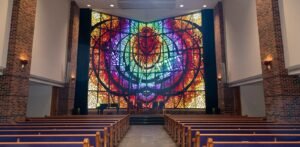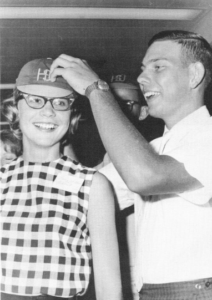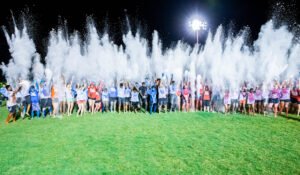HSU Traditions
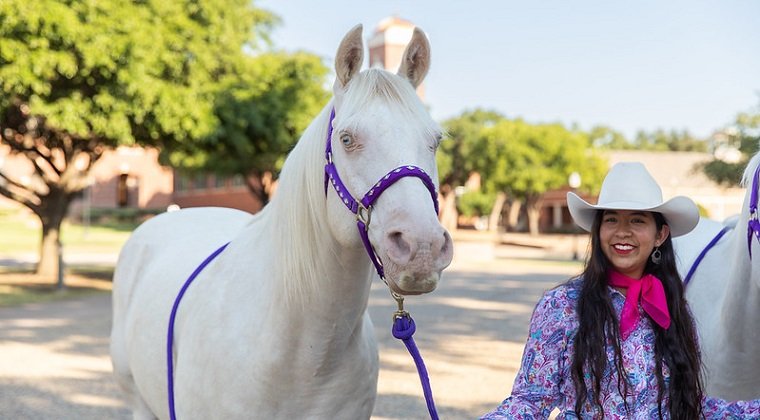
Hardin-Simmons University’s traditions connect generations of Cowboys, fostering pride, community, and faith. Some date back more than a century, while others are more recent, but all shape campus life. From cherished ceremonies to spirited rallies, these traditions honor our history and values, uniting students, alumni, faculty, and staff as one HSU family.
- Colors: Purple & Gold
- Fight Song: “Parade of the Purple and Gold”
- Mascot: Cowboy
- School Paper: The HSU Brand
- Yearbook: Bronco
- Literary Magazine: Corral
- Alumni Magazine: Range Rider
Central to Hardin-Simmons University’s mission—and foundational to our identity as a Christ-centered learning community—Chapel has shaped campus life for more than a century. Services first gathered in Abilene Hall in 1913, moved to the newly named Behrens Chapel in 1946, and continued in the rebuilt Behrens Chapel Auditorium after a fire in 1957. During Behrens’ renovation, undergraduate services met twice a week in Logsdon Chapel, a dedicated worship space known for its stunning 1988–89 stained-glass window. With the return to Behrens Chapel Auditorium, this tradition once again brings students together. Through every generation, Chapel has united our community in faith, fellowship, and the shared call to center our lives on Jesus Christ.
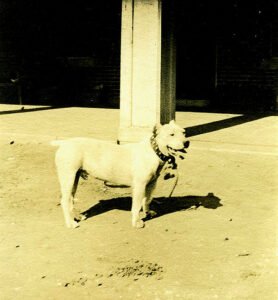
In 1916, Simmons College was graced with the introduction of Fritz, a white bulldog or large terrier (his heritage is unknown), owned by President Sandefer’s youngest son, Gib. Although his given name was Fritz, he soon earned another, more widely known moniker. There are speculative reasons for how he got the name Dam-it, from causing a cafeteria staff member to trip while carrying a tray full of food to students, or that it referenced his thoughts about losing his tail; either way, the name stuck. Dam-it quickly became the class of the 1920s mascot as he grew up with the class and integrated into the university’s culture.
He was taught the ever-popular game of fetch with both rocks and sticks and would carry the rocks around in his mouth wherever he went. Dam-it was allowed to roam all over campus, including classrooms, and laughter would ensue when he fell asleep in class, the rock would tumble out of his mouth, startle him awake, and cause a commotion until he had secured the rock once more in his jaws.
The story of Dam-it is, however, a tragedy, as he contracted pneumonia in January of 1920 and died only a few hours later. The impact he had on the university was on display at his funeral, which included a procession led by the Cowboy Band, four seniors serving as pallbearers, and a grave dug by freshmen. Senior class chaplain Ira Harrison led the service, speaking from the text “Every Dog has his Day.” Almost the entire student body and faculty were present for the funeral in the center of campus.
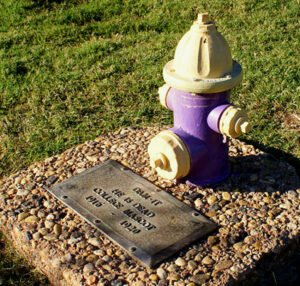
The story was picked up by the Associated Press and received national attention, with condolences coming from every part of the country. A marble tombstone was raised over his grave with the few words: Dam-it, He is Dead. Around 1950, a metal plate was installed in place of the chipped stone. At a later time, the memorial was relocated beside the Reflection Pond, and a purple and gold fire hydrant was dedicated in his memory.
After the death of Dam-it, the class of 1920 donated another canine mascot, this time a young Dalmatian, but Dam-it was irreplaceable. Although Dam-it has been gone from the campus of Hardin-Simmons University for over 90 years, his legacy lives on in the monument beside the pond and in the fire hydrant featured on every school ring.
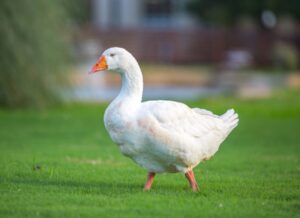 Gilbert, a goose that first lived at Nelson Park, made his way to Hardin-Simmons in the spring of 2013 when students brought him into Nix Hall as part of a prank. Soon, he relocated to the Reflection Pond at the heart of campus, and he quickly became a fixture of student life and HSU’s beloved unofficial mascot. Named for Gilbert Sandefer, son of longtime president Jefferson Davis Sandefer, he carries a connection to the university’s history as well as its traditions. Over the years, Gilbert has inspired the name of Gilbert’s Coffee Shop in Richardson Library, and each spring, his Birthday Bash unites students in food, games, and music. The celebration honors the feathered friend who has truly become part of the HSU family.
Gilbert, a goose that first lived at Nelson Park, made his way to Hardin-Simmons in the spring of 2013 when students brought him into Nix Hall as part of a prank. Soon, he relocated to the Reflection Pond at the heart of campus, and he quickly became a fixture of student life and HSU’s beloved unofficial mascot. Named for Gilbert Sandefer, son of longtime president Jefferson Davis Sandefer, he carries a connection to the university’s history as well as its traditions. Over the years, Gilbert has inspired the name of Gilbert’s Coffee Shop in Richardson Library, and each spring, his Birthday Bash unites students in food, games, and music. The celebration honors the feathered friend who has truly become part of the HSU family.
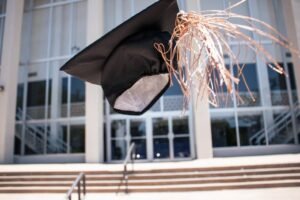 At Hardin-Simmons University, “Connected for Life” isn’t just a phrase—it’s a promise. From your first day on campus to long after graduation, you’ll build lifelong relationships rooted in faith, shared experiences, and the HSU spirit. Since our first graduating class in 1895, these bonds have united the Cowboy family across generations, creating a powerful network that supports, celebrates, and champions one another for life.
At Hardin-Simmons University, “Connected for Life” isn’t just a phrase—it’s a promise. From your first day on campus to long after graduation, you’ll build lifelong relationships rooted in faith, shared experiences, and the HSU spirit. Since our first graduating class in 1895, these bonds have united the Cowboy family across generations, creating a powerful network that supports, celebrates, and champions one another for life.
Homecoming has been a beloved Hardin-Simmons University tradition since its first recorded celebration on May 30–31, 1917, which coincided with graduation and featured a campus-wide barbecue and gala. Over the years, Homecoming shifted to align with athletic events—basketball during football’s hiatus years and football when the program was active. Even in 2020, when the football season was postponed due to COVID-19, the tradition carried on in spring 2021, returning to its fall schedule the following year.
Some traditions have endured for decades: alumni returning to campus, spirited competitions, and a shared sense of Cowboy pride. In the past, towering bonfires at the Rodeo Grounds brought students, alumni, and the community together for music and fellowship. Campus decorations once transformed the Forty Acres under a unifying theme, with residence halls and clubs competing for the most elaborate displays. The Homecoming Parade—complete with intricate floats, the Six White Horses, and the Cowboy Band—marched school spirit into downtown Abilene.
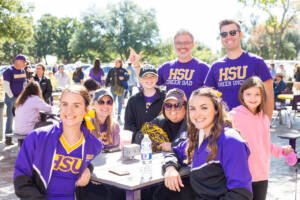 Other enduring traditions include the crowning of the University Queen and King, the presentation of prestigious alumni awards, and the long-running SING! competition. Introduced in 1962, SING! has become a cornerstone of Homecoming, with student performances uniting past and present Cowboys in celebration of music, creativity, and community.
Other enduring traditions include the crowning of the University Queen and King, the presentation of prestigious alumni awards, and the long-running SING! competition. Introduced in 1962, SING! has become a cornerstone of Homecoming, with student performances uniting past and present Cowboys in celebration of music, creativity, and community.
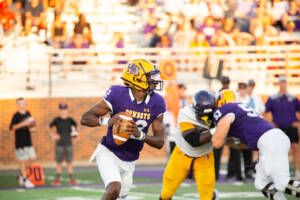 “HOOYAH” became a signature rallying cry for Hardin-Simmons in 1990, when the Cowboy football program returned after a 25-year hiatus. Head coach Jimmie Keeling gathered the team after their first practice since 1964, asking if anyone knew how the previous squads had ended practice.
“HOOYAH” became a signature rallying cry for Hardin-Simmons in 1990, when the Cowboy football program returned after a 25-year hiatus. Head coach Jimmie Keeling gathered the team after their first practice since 1964, asking if anyone knew how the previous squads had ended practice.
No one could recall a tradition, but defensive coordinator Bill McKinney, a former Marine and one of four full-time coaches on staff, stepped forward. He explained how the Marine Corps uses the phrase “Oorah” to motivate and unify.
The team chose to adapt the phrase in honor of both the Marines and HSU’s Cowboy heritage. From that moment, “HOOYAH” became more than just a word—it became a unifying shout heard across the university.
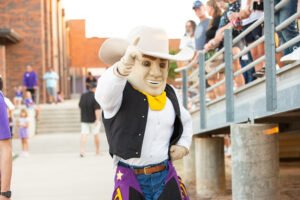 Hoss became the face of HSU’s reintroduced cowboy mascot in 2018, restoring a tradition that had been absent for decades. Named after Eric “Hoss” Cartwright from Bonanza—a character made famous by HSU alumnus Dan Blocker—Hoss was created to embody both rugged toughness and a gentle, Christ-inspired spirit. Today, he appears at sporting events and special occasions to ignite pride and spirit across campus.
Hoss became the face of HSU’s reintroduced cowboy mascot in 2018, restoring a tradition that had been absent for decades. Named after Eric “Hoss” Cartwright from Bonanza—a character made famous by HSU alumnus Dan Blocker—Hoss was created to embody both rugged toughness and a gentle, Christ-inspired spirit. Today, he appears at sporting events and special occasions to ignite pride and spirit across campus.
HSU Anthem
Hardin-Simmons, hail to thee,
for famous are thy halls;
Long may thy worth increase,
long live thy noble cause.
Great are thy victories
o’er land and over sea;
Fair daughter of the West
we love and honor thee.
HSU Fight Song (“Parade of the Purple and Gold”)
We’ll fight for dear old H-S-U.
Win or lose, we are all for you.
We’ll sing of all your praises true
And the might of the Cowboy school.
Our hearts will always loyal be
To the school and the team we love.
We’re going to fight, fight, fight,
We’re going to fight, fight, fight,
For the glory of the Purple and Gold.
The freshman beanie, first mentioned in The Corral in 1909, is one of HSU’s most enduring traditions. Originally bright green and yellow “Slime Caps” marked first-year students so upperclassmen could greet them—and so President Sandefer could easily spot them. Over the years, the beanie evolved to today’s purple and gold design with the HSU insignia. Once mandatory until the All-School Picnic, the tradition became optional in 1954, though it remains a hallmark of STAMPEDE’s Beanie Capping ceremony. Here, new students receive their caps, hear the cautionary tale of “Freddy Freshman,” and are welcomed into the Cowboy family with alumni ice cream and signatures.
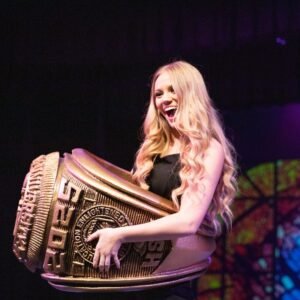 Introduced in 2004 by Hardin-Simmons University and the Alumni Association, the Official HSU Ring revived a long-lost tradition. For years, a single-design class identified HSU graduates; however, in the 1970s, the introduction of multiple styles and off-campus purchasing diluted its significance. The official program restored one unified design as a visible mark of academic accomplishment and school pride, reserved for qualifying students and alumni. Crafted in refined gold and crowned with the university seal, the ring’s symbols reflect Christ-centered learning and HSU history, from the Bible, cross, and flame to the lariat, Texas flags, bucking horse, and campus landmarks. Students wear the seal inward until graduation, then turn it outward as they step into the wider world. Traditions surrounding the ring—including the Sophomore Ring Dunk and the Official Ring Ceremony in Logsdon Chapel—unite generations of Cowboys and keep the university’s legacy alive.
Introduced in 2004 by Hardin-Simmons University and the Alumni Association, the Official HSU Ring revived a long-lost tradition. For years, a single-design class identified HSU graduates; however, in the 1970s, the introduction of multiple styles and off-campus purchasing diluted its significance. The official program restored one unified design as a visible mark of academic accomplishment and school pride, reserved for qualifying students and alumni. Crafted in refined gold and crowned with the university seal, the ring’s symbols reflect Christ-centered learning and HSU history, from the Bible, cross, and flame to the lariat, Texas flags, bucking horse, and campus landmarks. Students wear the seal inward until graduation, then turn it outward as they step into the wider world. Traditions surrounding the ring—including the Sophomore Ring Dunk and the Official Ring Ceremony in Logsdon Chapel—unite generations of Cowboys and keep the university’s legacy alive.
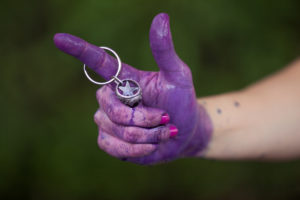 The Sophomore Ring Dunk at Hardin-Simmons University is a tradition where students, upon reaching the halfway point in their academic journey, celebrate by symbolically dunking a keychain ring in purple dye. This event, which started in 2008, signifies their progress and connection to the HSU community as they move closer to receiving their official HSU rings.
The Sophomore Ring Dunk at Hardin-Simmons University is a tradition where students, upon reaching the halfway point in their academic journey, celebrate by symbolically dunking a keychain ring in purple dye. This event, which started in 2008, signifies their progress and connection to the HSU community as they move closer to receiving their official HSU rings.
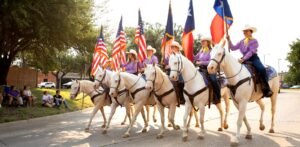 This esteemed parade began in the late 1920s when Will “Sheriff” Watson, a loyal HSU supporter, rode his white horse, Silver, at the head of our Cowboy Band during a parade. He was even dressed in Western gear to mirror the image of our famed music group. The tradition stuck, and Six White Horses was born. The riders proudly carry three Texas flags and three United States flags in every performance.
This esteemed parade began in the late 1920s when Will “Sheriff” Watson, a loyal HSU supporter, rode his white horse, Silver, at the head of our Cowboy Band during a parade. He was even dressed in Western gear to mirror the image of our famed music group. The tradition stuck, and Six White Horses was born. The riders proudly carry three Texas flags and three United States flags in every performance.
Six White Horses participates in parades, rodeos, school visits, and other civic and community events. Each year, student-riders try out to be part of this elite, Western-style team.
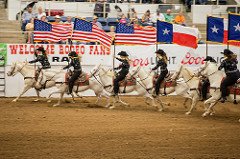 Dr. W.O. “Doc” Beazley directed the unit from 1962 to 1998, and during that time, he also authored several books aimed at teaching children about horses, which used actual Six White Horses in the stories.
Dr. W.O. “Doc” Beazley directed the unit from 1962 to 1998, and during that time, he also authored several books aimed at teaching children about horses, which used actual Six White Horses in the stories.
STAMPEDE is HSU’s new-student orientation, introducing the college experience through campus traditions, community, and connection. From receiving the iconic purple and gold beanie to sharing meals and games with classmates, STAMPEDE blends fun, friendship, and preparation for the journey ahead.
Over several days, incoming freshmen meet upper-class students, faculty, and staff; discover HSU’s history; and gain the tools they need to thrive both in and out of the classroom.
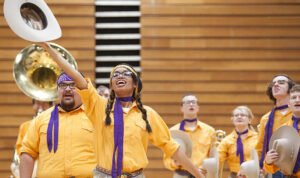 The “World Famous” Cowboy Band played its first note in 1923. Since then, this group of musicians has been an important part of HSU and regional celebrations.
The “World Famous” Cowboy Band played its first note in 1923. Since then, this group of musicians has been an important part of HSU and regional celebrations.
Each year, this Western-clad ensemble participates in parades, games, rodeos, and other performances on and off campus. The Band has traveled to more than a dozen countries and marched in the inaugural parades of six U.S. presidents: Herbert Hoover, Franklin D. Roosevelt, Dwight D. Eisenhower, Richard M. Nixon, Jimmy Carter, and George W. Bush.
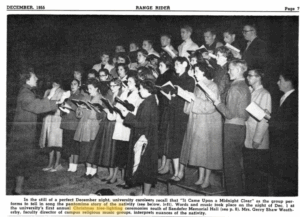 The annual Christmas tree lighting has been a cherished HSU tradition since 1955, first organized by the social committee and the Baptist Student Union (now Baptist Student Ministry) to bring together clubs, organizations, students, faculty, and staff. Each group contributed—decorating, reading the Christmas story, providing food, and more.
The annual Christmas tree lighting has been a cherished HSU tradition since 1955, first organized by the social committee and the Baptist Student Union (now Baptist Student Ministry) to bring together clubs, organizations, students, faculty, and staff. Each group contributed—decorating, reading the Christmas story, providing food, and more.
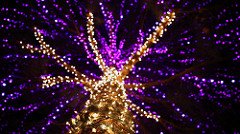 Today, the celebration continues on Anderson Lawn, where the campus gathers for the tree lighting, storybook reading, cookies, crafts, carols, and cocoa, capped by a festive dinner and holiday concert.
Today, the celebration continues on Anderson Lawn, where the campus gathers for the tree lighting, storybook reading, cookies, crafts, carols, and cocoa, capped by a festive dinner and holiday concert.
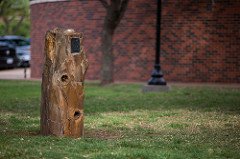 In front of historic Abilene Hall stands one of Hardin-Simmons University’s most unusual landmarks—a large petrified tree stump, mounted on a cement base and believed by some to be the finest specimen in West Texas. The story of how it arrived on campus has become part of HSU legend. For years, students whispered that members of the senior class of 1919 had spotted the stump on a farm south of Clyde, spirited it away under cover of night, and placed it on the campus as a “gift.” The late D.Q. Riddle, editor of the Bronco and a member of the 1919 class, is credited with bringing the stump to campus. The Simmons Brand even reported at the time that the senior class had decided to “plant an already acclimated tree” to withstand the harsh West Texas climate. Over the years, conflicting accounts circulated—some claimed the stump was purchased, others said it had been shipped from Arizona. The truth emerged when Dr. J.M. Estes, on whose land the stump was found, explained that he had given the seniors permission to take it, as he had dozens on his property and considered them in the way. The stump, broken into three pieces, came to HSU with the largest section placed prominently on campus. While the “stolen tree” tale has since been debunked, the legend still lives on in the spirit of the class of 1919, who remain campus folk heroes in this enduring and lighthearted tradition.
In front of historic Abilene Hall stands one of Hardin-Simmons University’s most unusual landmarks—a large petrified tree stump, mounted on a cement base and believed by some to be the finest specimen in West Texas. The story of how it arrived on campus has become part of HSU legend. For years, students whispered that members of the senior class of 1919 had spotted the stump on a farm south of Clyde, spirited it away under cover of night, and placed it on the campus as a “gift.” The late D.Q. Riddle, editor of the Bronco and a member of the 1919 class, is credited with bringing the stump to campus. The Simmons Brand even reported at the time that the senior class had decided to “plant an already acclimated tree” to withstand the harsh West Texas climate. Over the years, conflicting accounts circulated—some claimed the stump was purchased, others said it had been shipped from Arizona. The truth emerged when Dr. J.M. Estes, on whose land the stump was found, explained that he had given the seniors permission to take it, as he had dozens on his property and considered them in the way. The stump, broken into three pieces, came to HSU with the largest section placed prominently on campus. While the “stolen tree” tale has since been debunked, the legend still lives on in the spirit of the class of 1919, who remain campus folk heroes in this enduring and lighthearted tradition.
